Vision 2030 - National Research Centre for Grapes
Vision 2030 - National Research Centre for Grapes
Vision 2030 - National Research Centre for Grapes
Create successful ePaper yourself
Turn your PDF publications into a flip-book with our unique Google optimized e-Paper software.
<strong>Vision</strong> <strong>2030</strong><br />
<strong>National</strong> <strong>Research</strong> <strong>Centre</strong> <strong>for</strong> <strong>Grapes</strong><br />
(Indian Council of Agricultural <strong>Research</strong>)<br />
P.B. No.3, Manjri Farm P.O., Solapur Road, Pune – 412307<br />
Tel.: 91-20-26956000, Fax: 91-20-26956099<br />
Email: dirnrcg@icar.org.in<br />
http://nrcgrapes.nic.in
Printed : June 2011<br />
Compiled and edited : Dr. P. G. Adsule<br />
Dr. Anuradha Upadhyay<br />
Dr. Indu S. Sawant<br />
All Rights Reserved<br />
2011, <strong>National</strong> <strong>Research</strong> <strong>Centre</strong> <strong>for</strong> <strong>Grapes</strong>, Pune<br />
Published by Dr. P. G. Adsule<br />
The Director, <strong>National</strong> <strong>Research</strong> <strong>Centre</strong> <strong>for</strong> <strong>Grapes</strong>, Pune<br />
Printed by :<br />
Flamingo Business Systems, Pune 411 009. Tel. 020-24214636
Contents<br />
Foreword<br />
Preface<br />
Preamble<br />
i<br />
iii<br />
v<br />
Viticulture Scenario 1<br />
<strong>National</strong> <strong>Research</strong> <strong>Centre</strong> <strong>for</strong> <strong>Grapes</strong> 3<br />
NRC <strong>Grapes</strong> <strong>2030</strong> 5<br />
Harnessing Science 7<br />
Strategy and Framework 10<br />
Epilogue 12<br />
References 12<br />
Annexure 1: Strategic framework 13
Foreword<br />
The diverse challenges and constraints as growing<br />
population, increasing food, feed and fodder needs, natural<br />
resource degradation, climate change, new parasites, slow<br />
growth in farm income and new global trade regulations<br />
demand a paradigm shift in <strong>for</strong>mulating and implementing<br />
the agricultural research programmes. The emerging scenario<br />
necessitates the institutions of ICAR to have perspective vision<br />
which could be translated through proactive, novel and<br />
innovative research approach based on cutting edge science.<br />
In this endeavour, all of the institutions of ICAR, have revised<br />
and prepared respective <strong>Vision</strong>-<strong>2030</strong> documents highlighting<br />
the issues and strategies relevant <strong>for</strong> the next twenty years.<br />
The <strong>National</strong> <strong>Research</strong> <strong>Centre</strong> <strong>for</strong> <strong>Grapes</strong> (NRCG), Pune<br />
is an apex institution in the country spearheading viticultural<br />
and enology research <strong>for</strong> productivity enhancement and<br />
diversification of Indian viticulture into value added products<br />
like raisins, wine besides juice. The comprehensive initiatives<br />
taken by the Council through NRCG have led to notable<br />
accomplishments in crop improvement, production<br />
technologies to overcome several production constraints and<br />
value addition through technological interventions.<br />
Developing high yielding and good quality table and industrial<br />
use varieties with basal resistance to the biotic and abiotic<br />
stresses, and technology generation <strong>for</strong> greater input use<br />
efficiency, integrated pest management, post-harvest handling,<br />
processing, packaging including value-addition are the major<br />
research programmes at this <strong>Centre</strong>.<br />
It is expected that the analytical approach and <strong>for</strong>ward<br />
i
<strong>National</strong> <strong>Research</strong> <strong>Centre</strong> <strong>for</strong> <strong>Grapes</strong>, Pune<br />
looking concepts presented in the ‘<strong>Vision</strong> <strong>2030</strong>’ document will prove<br />
useful <strong>for</strong> the researchers, policymaker, and stakeholders to address the<br />
future challenges <strong>for</strong> growth and development of the agricultural sector<br />
and ensure food and income security with a human touch.<br />
(S. AYYAPPAN)<br />
Secretary,<br />
Department of Agricultural <strong>Research</strong> & Education (DARE) and<br />
Director-General, Indian Council of Agricultural <strong>Research</strong> (ICAR)<br />
Krishi Bhavan, Dr. Rajendra Prasad Road<br />
New Delhi – 110 114<br />
Dated the 29 th June, 2011<br />
New Delhi<br />
ii
Preface<br />
The country is in the midst of a horticulture revolution.<br />
Grape is emerging as an important fruit crop of India; it has<br />
the third highest productivity and is the highest among fruit<br />
crops in earning <strong>for</strong>eign exchange. Further, it is receiving<br />
importance in creating jobs on the farm and other related<br />
sectors. With this background a <strong>National</strong> <strong>Research</strong> Center was<br />
started in the VIII Plan especially to cater to research needs of<br />
the grape industry of India. At present out of total estimated<br />
area of 5.34 million ha under fruit crops in India, grape<br />
occupies 106 thousand hectares mainly producing table<br />
grapes. However, with the recent trend of wine making, the<br />
sector is growing at a very high rate of 25-30 per cent per year<br />
and there<strong>for</strong>e, the research programmes in this sector will be<br />
focused more in the coming years.<br />
The grape growers of India are a highly dedicated and<br />
committed group, and are ready to make a mark in the world<br />
grape trade. It is mainly through their ef<strong>for</strong>ts that grape<br />
cultivation has slowly emerged from the unorganized to an<br />
organized sector. Not only the elite group of growersexporters<br />
but a large number of smaller growers, too, have<br />
become aware of the Good Agricultural Practices (GAP), and<br />
are even complying with the Europe GAP standards.<br />
In the first decade of its existence, the <strong>Centre</strong> had made<br />
concerted ef<strong>for</strong>ts to develop strong linkages with the growers<br />
and their associations to understand the problems faced by<br />
them. Many issues related to grape production were resolved<br />
based on existing knowledge, surveys and laboratory and field<br />
studies. The <strong>Centre</strong> gave due importance to Transfer of<br />
iii
<strong>National</strong> <strong>Research</strong> <strong>Centre</strong> <strong>for</strong> <strong>Grapes</strong>, Pune<br />
Technology (TOT) and this investment in TOT has enhanced its credibility<br />
among peer groups and stakeholders.<br />
It is hoped that this document ‘VISION <strong>2030</strong>’ will serve as a<br />
background paper <strong>for</strong> the officials of the GOI, MOA, DARE, ICAR to<br />
plan <strong>for</strong> the critical inputs to this <strong>Centre</strong>, especially in terms of manpower,<br />
finance, international collaboration and human resource development to<br />
enable it to meet the future challenges posed by the grape industry of India.<br />
Help received from Dr. Anuradha Upadhyay, Dr. Indu Sawant and other<br />
colleagues of the Institute in preparation of this document is highly<br />
appreciated.<br />
Dated 30 th June 2011<br />
Pune<br />
(P. G. ADSULE)<br />
Director<br />
iv
Preamble<br />
<strong>National</strong> <strong>Research</strong> <strong>Centre</strong> <strong>for</strong> <strong>Grapes</strong>, Pune was<br />
established in January 1997 to undertake mission-oriented<br />
research to address the issues related to grape production and<br />
processing in India. During last thirteen years, the institute<br />
has made tremendous progress in terms of infrastructure<br />
development, research output and technology dissemination.<br />
With a few rented rooms in the office of the Maharashtra<br />
Rajya Draksh Bagaitdar Sangh (MRDBS) in Manjri in the<br />
beginning, the institute now has a laboratory cum<br />
administrative building, separate buildings of biocontrol<br />
laboratory, <strong>National</strong> Referral Laboratory, farm office, raisin<br />
shed, three poly/FRP houses and experimental vineyards<br />
spread over 17 ha. The institute has now world-class research<br />
infrastructure in terms of high tech instruments and tools. LC-<br />
MS/MS, GC-MS/MS-TOF, ICP-MS, genetic analyzer, real<br />
time PCR machine, IRGA, canopy analyzer, wine analyzer,<br />
AAS, multichannel autoanalyzer, programmable ELISA plate<br />
reader, plant growth chamber and incubators, stereo<br />
microscopes of high magnification, different types of<br />
centrifuges are some of the high-tech equipments available <strong>for</strong><br />
conducting basic and strategic research.<br />
The institute is the site <strong>for</strong> <strong>National</strong> Grape Gene Bank and<br />
has almost 425 grape accessions in its field germplasm<br />
collection. Such an excellent infrastructure has resulted in<br />
recognition of the <strong>Centre</strong> <strong>for</strong> postgraduate studies by Pune<br />
University, Pune and Shivaji University, Kolhapur besides<br />
other universities in the country and every year several<br />
students complete their six months project work at this<br />
Institute. A nursery with a three star rating from NHB<br />
v
<strong>National</strong> <strong>Research</strong> <strong>Centre</strong> <strong>for</strong> <strong>Grapes</strong>, Pune<br />
provides true to type and genuine and disease-free planting material of<br />
promising rootstock and commercial table and wine grape varieties.<br />
Transfer of technology through regular field visits of scientists of the<br />
Institute and their participation in growers’ seminars, in house interaction,<br />
training programmes and in<strong>for</strong>mation placed on website has increased the<br />
Institute’s clear visibility and credibility among the growers and other<br />
stakeholders of grape industry. Successful implementation of APEDA<br />
funded Pesticide Residue Monitoring Plan <strong>for</strong> export grape has contributed<br />
substantially to the stature of the Institute.<br />
o<br />
vi
Viticulture Scenario<br />
Viticulture in India started in early 1960 and today assumes an<br />
important position in horticulture crop in view of its area occupied,<br />
production, value addition and job creation in both rural and urban areas.<br />
Today grape has occupied an area of 106 thousand ha with a total<br />
production of 974 thousand tonnes. However, the highest production of<br />
1.88 million tonnes has been reported from an area of 80 thousand ha<br />
during 2008-09. Majority of the area is occupied by table grapes and<br />
leaving a small portion in the range of 3000 to 5000 ha under wine grapes.<br />
Major area in the country is spread in the States of Maharashtra (to the<br />
extent of 70 to 80 per cent in Nasik, Solapur, Sangli, Satara, Pune and<br />
Latur districts) followed by Karnataka (Bijapur, Bangalore, Belgum,<br />
Gulbarga, Raichur districts), Andhra Pradesh (Hyderabad and Ranga<br />
Reddy districts) and Tamil Nadu (Theni, Coimbatore, Madurai districts)<br />
and small parts in North Indian States (Punjab, Uttar Pradesh, Haryana,<br />
Himachal Pradesh, Jammu & Kashmir) and East Indian States. Area is<br />
now further increasing in Karnataka and Tamil Nadu in view of their policy<br />
measures <strong>for</strong> the promotion of wine grape cultivation <strong>for</strong> wine purpose.<br />
Among all the horticultural crops, this fruit has received a special<br />
importance in view of its value addition into raisin almost 18 to 20 per<br />
cent, wine 1 to 2 per cent, juice 0.5 per cent and export 3.5 per cent to<br />
European Union, Gulf countries and Bangladesh. Raisin and wine<br />
production has reached to 1 lakh tonnes and 13.2 million litres respectively.<br />
In view of increasing production of raisins and wine <strong>for</strong> local<br />
consumption and also <strong>for</strong> export, grape cultivation is receiving a lot of<br />
attention <strong>for</strong> its improved varieties and accessions, vineyard establishment,<br />
propagation and nursery techniques, training and pruning system, inputs<br />
such as irrigation, fertilizers and use of various agrochemicals to improve<br />
the quality of table and wine grapes and management of various disease<br />
1
<strong>National</strong> <strong>Research</strong> <strong>Centre</strong> <strong>for</strong> <strong>Grapes</strong>, Pune<br />
and insect pests. Globally grape cultivation is concentrated in temperate<br />
and subtropical regions and mainly used <strong>for</strong> wine production, while our<br />
grape cultivation is confined to tropical and peninsular belt and mainly<br />
used <strong>for</strong> fresh purpose i.e. table purpose and now started diversification to<br />
raisin, wine and juice. Being in tropical region, the incidence of insect pests<br />
and disease is more and the plant is ever-growing without any rest period<br />
(dormancy) which is contrary in temperate cultivation. As a result of these<br />
factors, our requirements of inputs and its cost apart from labour<br />
requirements are more as compared to temperate cultivation. Further, the<br />
climate change in terms of untimely precipitation in annual cycle of crop<br />
and stress of heat and other climatic factors also influences the productivity<br />
and quality of crop. Considering these factors in the tropical grape<br />
cultivation, our research priorities are different and concentrated to<br />
overcome these problems with optimum and quality grape production at<br />
globally competitive price <strong>for</strong> both table purpose and other processed<br />
products such as raisin and wine.<br />
In view of contribution of viticulture to national economy, ef<strong>for</strong>ts<br />
towards small holders viticulture, deteriorating production environment,<br />
climate change and viticulture, emergence of agribusiness and more<br />
sustainable grape production with quality at globally competitive cost of<br />
production, developments of technologies in molecular biology,<br />
biotechnology, nanotechnology, in<strong>for</strong>mation technology and geo-spatial<br />
technology would certainly provide significant new opportunities <strong>for</strong><br />
productivity enhancement with the solution to various problems and<br />
challenges being faced by the various stakeholders of viticulture industry.<br />
o<br />
2
<strong>National</strong> <strong>Research</strong> <strong>Centre</strong> <strong>for</strong> <strong>Grapes</strong><br />
<strong>National</strong> <strong>Research</strong> <strong>Centre</strong> <strong>for</strong> <strong>Grapes</strong>, Pune was established in January<br />
1997 to undertake mission-oriented research to address the issues related<br />
to grape production and processing in India. During last thirteen years,<br />
the institute has made tremendous progress in terms of infrastructure<br />
development, research output and technology dissemination. The institute<br />
has world-class research infrastructure in terms of high tech instruments<br />
and tools <strong>for</strong> conducting basic and strategic research. The institute is the<br />
site <strong>for</strong> <strong>National</strong> Grape Gene Bank and has almost 425 grape accessions in<br />
its field germplasm collection. A nursery with a three star rating from NHB<br />
provides pure and genuine planting material of promising rootstock and<br />
commercial table and wine grape varieties. Transfer of technology through<br />
regular field visits, growers’ seminars, in-house interaction with grape<br />
growers, training programmes and in<strong>for</strong>mation placed on website has<br />
increased the Institute’s clear visibility and credibility among the growers<br />
and other stakeholders of grape industry. Successful implementation of<br />
APEDA funded Pesticide Residue Monitoring Plan <strong>for</strong> export grape has<br />
contributed substantially to the stature of the Institute<br />
Mandate<br />
To undertake the programmes covering basic and strategic research <strong>for</strong><br />
resolving the major biotic and abiotic constraints affecting the grapes<br />
quality production, productivity, to sustain the productivity, promote<br />
diversification towards wine and other value added products and<br />
evaluation of technologies <strong>for</strong> developing region specific technologies.<br />
Since its inception in 1997, the <strong>Centre</strong> has developed several<br />
technologies <strong>for</strong> grape industry. These include a variety ‘Manjri Naveen’<br />
suitable <strong>for</strong> export, irrigation and fertilizer schedule <strong>for</strong> precision farming,<br />
rootstocks <strong>for</strong> sustained production under adverse condition, canopy<br />
management and judicious use of bioregulators <strong>for</strong> quality improvement,<br />
3
<strong>National</strong> <strong>Research</strong> <strong>Centre</strong> <strong>for</strong> <strong>Grapes</strong>, Pune<br />
weather based disease <strong>for</strong>ecasting and advisory <strong>for</strong> disease management,<br />
bioefficacy and dissipation of several new molecules <strong>for</strong> their inclusion in<br />
IPM, assessment of quality standards <strong>for</strong> Indian raisins and wine.<br />
The <strong>Centre</strong> has developed linkages and partnership with grape industry<br />
stake holders like state grape growers association, wine industry, state<br />
horticulture department, <strong>National</strong> Horticulture Board, Agricultural and<br />
Processed Food Products Export Development Authority, Indian Grape<br />
Processing Board, etc. It has partnership with several national agencies like<br />
Department of Biotechnology, Bhabha Atomic <strong>Research</strong> <strong>Centre</strong>,<br />
University of Pune, Shivaji University, Kolhapur apart from other<br />
universities and private sectors involved in agri-business.<br />
o<br />
4
NRC <strong>Grapes</strong> <strong>2030</strong><br />
<strong>Vision</strong><br />
Harnessing viticulture and enology Science to ensure comprehensive<br />
and sustained grape production through crop improvement, assessment,<br />
refinement and adoption of most appropriate and precisive technologies in<br />
grape production and value addition thereby increasing net returns to<br />
grape growers and all the stakeholders involved in the industry.<br />
Mission<br />
To undertake the programmes involving basic and strategic research<br />
<strong>for</strong> resolving the major biotic and abiotic constraints affecting the grape<br />
production, productivity and its quality and to have sustained productivity<br />
and promote diversification to wine production and other value added<br />
products<br />
Focus<br />
i. Genetic resource enhancement, its evaluation and valuation <strong>for</strong><br />
effective use to meet the challenges of biotic and abiotic stresses besides<br />
yield, quality and nutritional value.<br />
ii.<br />
Development of cultivars / production technology which can fit into<br />
achieving vertical growth and can sustain the impact of climate change,<br />
biotic and abiotic stresses and also to meet the consumers’ requirement.<br />
iii. Utilize the tools of bio-in<strong>for</strong>matics <strong>for</strong> collation, retrieval analysis and<br />
use of biological in<strong>for</strong>mation and decision making process and to<br />
achieve maximum output.<br />
iv. Developing efficient system <strong>for</strong> management of nutrient and water to<br />
get maximum utilisation of these resources.<br />
5
<strong>National</strong> <strong>Research</strong> <strong>Centre</strong> <strong>for</strong> <strong>Grapes</strong>, Pune<br />
v. Developing a model <strong>for</strong> plant architectural engineering and its<br />
management to harness maximum solar energy and other inputs.<br />
vi. Develop effective integrated management strategies <strong>for</strong> the biotic<br />
stresses to reduce the production losses including <strong>for</strong>ecasting models,<br />
biocontrol system, and development of diagnostic techniques.<br />
vii. Develop a system <strong>for</strong> protecting cultivation to have maximum output<br />
from reduce land through development of cultivars and technologies<br />
suitable <strong>for</strong> protected cultivation.<br />
viii.Develop post-harvest technologies <strong>for</strong> value enhancement, reduction of<br />
losses and increased marketability.<br />
ix. Generation of eco-region specific technologies.<br />
x. Use of biotechnology, bioremediation, biosecurity, bioprospection and<br />
nanotechnology etc. <strong>for</strong> sustained grape production.<br />
xi. Mechanization <strong>for</strong> improved input use efficiency.<br />
xii. Inter-institutional networking <strong>for</strong> achieving the above goals.<br />
o<br />
6
Harnessing Science<br />
The <strong>National</strong> <strong>Research</strong> <strong>Centre</strong> <strong>for</strong> <strong>Grapes</strong> would strive to harness<br />
power of science in increasing productivity, enhancing input-use efficiency,<br />
reducing cost and post-harvest losses, minimizing risks and improving<br />
quality of grape through conventional techniques as well as new science<br />
and tools. It would also attempt to realize diverse interests of different<br />
stakeholders in the food-supply chains.<br />
In the present context, technological challenges are becoming more<br />
complex than be<strong>for</strong>e as demand <strong>for</strong> food is increasing and supply sources<br />
are dwindling. Incidentally, the science is also changing rapidly with the<br />
emergence of new tools, methods, techniques and approaches that promise<br />
technological breakthroughs to accomplish the mission.<br />
Potential of genetic-resource enhancement<br />
Much of the gains in the productivity of the food commodities in the<br />
past have been attributed to the genetic alterations of the crops and<br />
animals. This will continue to be the primary driver <strong>for</strong> augmenting<br />
productivity in the lesser time, space and cost. The NRC <strong>Grapes</strong> is the<br />
<strong>National</strong> active repository <strong>for</strong> grapes and has about 425 grape accessions.<br />
To address future needs of grape industry in India, the research will focus<br />
on characterization, genetic enhancement through clonal selection<br />
breeding <strong>for</strong> commercially important traits, development of tools <strong>for</strong><br />
molecular breeding, functional genomics, proteomics, gene mining,<br />
molecular breeding through tools like marker-aided selection and gene<br />
stacking.<br />
Biotechnology<br />
Biotechnology has a considerable potential to address many of the<br />
challenges in the grape. Biotechnology tools like MAS will be developed<br />
7
<strong>National</strong> <strong>Research</strong> <strong>Centre</strong> <strong>for</strong> <strong>Grapes</strong>, Pune<br />
to speed up the grape breeding <strong>for</strong> important traits. Transcriptome and<br />
Proteome analysis would be taken up to elucidate the gene functioning.<br />
Management of natural resources to improve production efficiency<br />
More than 80 % of the grape cultivation is confined to the agro<br />
ecological zone 6 (hot semi-arid eco-region). Moisture stress and salinity<br />
are the key problems faced by the farming community <strong>for</strong> sustaining grape<br />
productivity. Ground water is the major contributing factor to salinity.<br />
The nutrient and water use efficiency is very poor because of poor physicochemical<br />
properties of the soil, uncertainty in water availability and poor<br />
quality irrigation water.<br />
The Soil organic pool is central to improving the fertility status of soil.<br />
Thus integrated nutrient management incorporating the judicious<br />
combination of organics, biofertilizers and inorganics and nutrient use<br />
based on stock-scion (Variety) combination to mitigate different abiotic<br />
stresses is needed. Seasonal changes in climatic conditions are impacting<br />
grape productivity through observable changes in terms of phenological<br />
events, such as budburst, flowering, veraison, harvest and finally yield.<br />
Thus, Nutrient and Irrigation schedule needs to be perfected/ standardised<br />
under such situations.<br />
The per<strong>for</strong>mance of the vines deteriorate when raised on own roots<br />
and hence, rootstocks like Dog Ridge, 110R and others have become<br />
central to the successful table and wine grape cultivation respectively in<br />
the country. But, there is a continuous need <strong>for</strong> evaluating newer<br />
rootstocks <strong>for</strong> their salinity and drought tolerance in the field to cope up<br />
with ever increasing problems of drought and salinity.<br />
Bio-risk management<br />
Bio-risk is increasing with climate change and owing to trans-boundary<br />
insect-pests and diseases. It is adding cost, reducing food production and<br />
is adversely affecting farm income. To overcome problem of bio-risk,<br />
ef<strong>for</strong>ts would be made to develop effective and integrated risk-and-disaster<br />
management production systems and institutional mechanisms, which<br />
would bear risk. Bio-risk intelligent system (such as early warning systems,<br />
drought indicators, migratory movement of bio-risk agents, etc.) would be<br />
developed <strong>for</strong> taking in<strong>for</strong>med decision at the local, regional and national<br />
level.<br />
8
<strong>Vision</strong> <strong>2030</strong><br />
Diversification<br />
Diversification <strong>for</strong> value addition and to prevent market glut has great<br />
potential. <strong>Research</strong> focus would be to develop technologies <strong>for</strong> improved<br />
and cost competitive raisins, wine and juice, enhancing shelf life <strong>for</strong> table<br />
grape and improving commercial traits like size and colour through pre<br />
and post-harvest approaches. Attempts will also be made to explore and<br />
promote alternate uses of grape like medicinal / antioxidants, distillery,<br />
pigment, etc.<br />
Technology transfer systems<br />
It is important to continuously strive to develop new and better<br />
technologies. Their effective delivery mechanism would greatly help in<br />
bringing wide gap between the potential and the realized productivity.<br />
More far-reaching, participatory in<strong>for</strong>mation and communication<br />
technology would be evolved by optimizing print and delivery systems and<br />
by showcasing research products <strong>for</strong> effectively linking research<br />
accomplishments with the stakeholders.<br />
Human resource development<br />
Enhancing quality of human resource is a pre-requisite <strong>for</strong><br />
implementing and upgrading research programmes, developing<br />
technologies, evolving institutional arrangements to face challenges and<br />
harness opportunities. Maintaining global standards and enhancing<br />
competitiveness are equally important in agri-business and in technology<br />
development. Ef<strong>for</strong>ts will be made to develop state-of-the art infrastructure<br />
and to enhance competence.<br />
o<br />
9
Strategy and Framework<br />
A 4-point following strategy would be adopted to accomplish the<br />
vision and the goals of the NRC <strong>for</strong> <strong>Grapes</strong> (see Annexure 1).<br />
• Improve efficiency of human and financial resources and effective<br />
utilization of infrastructure.<br />
– Formulate multidisciplinary eco-region-wise research and<br />
technology development programmes with national and<br />
international agencies;<br />
– Prioritize demand-driven research programme with focus on<br />
emerging market opportunities and stakeholders’ requirements<br />
including requirements of grape industry;<br />
– Support grape cultivation in non-traditional areas by providing<br />
research and technology inputs.<br />
– Harness synergies of partners and stakeholders in developing<br />
improved technologies, systems and in<strong>for</strong>mation <strong>for</strong> viticulture and<br />
enology.<br />
• Facilitate accelerated dissemination of improved technologies,<br />
knowledge and in<strong>for</strong>mation.<br />
– Develop and evolve models to link research and development<br />
activities with farmers and other stakeholders through in<strong>for</strong>mation<br />
and communication technology and e-extension;<br />
– Provide state-of-the art scientific facilities in laboratories and<br />
infrastructure;<br />
– Address food safety concerns of the society.<br />
10
<strong>Vision</strong> <strong>2030</strong><br />
• Enhance quality of human resource in agri-supply chain.<br />
– Provide training in latest technical innovations to stakeholders in<br />
grape production and marketing chain.<br />
– Provide training to scientists in niche areas.<br />
– Develop an accountable, professional, motivated and intellectual<br />
property rights-compatible, work culture; and<br />
– Facilitate in strengthening and streamlining higher viticulture and<br />
enology research system to meet future challenges.<br />
• Commercialization of technologies through organized intellectual<br />
property rights and benefit-sharing system.<br />
– Facilitate and ensure IPR wherever applicable.<br />
o<br />
11
Epilogue<br />
The <strong>National</strong> <strong>Research</strong> <strong>Centre</strong> <strong>for</strong> <strong>Grapes</strong> is continued to bring a<br />
demand driven technologies in order to sustain the grape productivity per<br />
unit area with better quality at competitive cost of production technology.<br />
The viticulture and enology research would certainly augment farmers’<br />
income, generate employment opportunities, promote exports and restrict<br />
inputs and increase value addition <strong>for</strong> higher and inclusive growth of this<br />
sector. Ef<strong>for</strong>ts would also be made to sensitize and facilitate in creating<br />
favourable institutional support to all stakeholders of grape industry.<br />
Concentrated ef<strong>for</strong>ts would be made to be more sensitive to the<br />
immediate needs of grape growers. It would also develop mechanisms to<br />
regularly monitor various changes occurring at national and international<br />
level to develop appropriate research and other strategies to respond to the<br />
changes <strong>for</strong> the benefit of the stakeholders. All this would be attempted in<br />
a participatory mode by becoming more vigilant and introducing<br />
institutional processes which will develop a culture of responsibility,<br />
accountability and integrity of science.<br />
o<br />
References<br />
1. http:// www.fao.org, FAOSTAT (ProdStat), 2009<br />
2. http://www.nhb.gov.in/<br />
3. <strong>Vision</strong> <strong>2030</strong>. ICAR, New Delhi.<br />
12
<strong>Vision</strong> <strong>2030</strong><br />
Annexure 1 : Strategic framework<br />
Goal Approach Per<strong>for</strong>mance measure<br />
Widen the genetic<br />
base to maintain<br />
sustained grape<br />
production under<br />
changing global<br />
scenario and also<br />
the climate change<br />
Collection, characterization, documentation<br />
and conservation of grape germplasm.<br />
Screening and evaluation of grape<br />
germplasm <strong>for</strong> biotic and abiotic stresses,<br />
suitability <strong>for</strong> different purposes, quality and<br />
yield parameters.<br />
Breeding <strong>for</strong> improved yield and quality in<br />
table and wine grape.<br />
Use of biotechnological tools to understand<br />
and tackle different issues.<br />
Varieties/ hybrids<br />
developed/ released <strong>for</strong><br />
different purposes<br />
Desired levels of yield,<br />
quality and tolerance to<br />
biotic/ abiotic stresses.<br />
Marker associated with<br />
QTLS<br />
Improve risk<br />
management<br />
Address climate risk in viticulture<br />
Approaches <strong>for</strong> climate change adaptation<br />
and mitigation<br />
Address market risk<br />
Support to farmer friendly insurance<br />
products to address climate change<br />
Minimization of risk due<br />
to climate<br />
Early warning systems,<br />
weather based<br />
<strong>for</strong>ecasting systems<br />
Enhance<br />
competitiveness of<br />
Indian grape and<br />
processed<br />
products<br />
Develop technologies to reduce cost of<br />
production of grape<br />
Develop horticultural practices <strong>for</strong><br />
improving quality of grape and processed<br />
products<br />
Improve input use efficiency<br />
Number of technologies<br />
developed and<br />
transferred<br />
Improved cost: benefit<br />
ratio<br />
Maintain and<br />
improve the status<br />
and quality of<br />
natural resources<br />
Management options to improve soil quality<br />
Technological options to enhance water use<br />
efficiency<br />
Management strategies <strong>for</strong> saline and<br />
alkaline soils<br />
Number of technologies<br />
developed and<br />
transferred<br />
Improve<br />
production of<br />
grapes as per food<br />
safety standards<br />
Develop technologies <strong>for</strong> safe use of<br />
agrochemicals and other inputs<br />
Develop technology to minimize reliance on<br />
agrochemicals<br />
Develop strategies to monitor the food<br />
contaminant to enhance food safety and<br />
compliance to food laws.<br />
No. of technologies<br />
developed<br />
Less or no rejection of<br />
produce in the market<br />
and compliance to food<br />
laws<br />
13
<strong>National</strong> <strong>Research</strong> <strong>Centre</strong> <strong>for</strong> <strong>Grapes</strong>, Pune<br />
Goal Approach Per<strong>for</strong>mance measure<br />
Improve<br />
production of<br />
grapes as per food<br />
safety standards<br />
Develop technologies <strong>for</strong> safe use of<br />
agrochemicals and other inputs<br />
Develop technology to minimize reliance on<br />
agrochemicals<br />
Develop strategies to monitor the food<br />
contaminant to enhance food safety and<br />
compliance to food laws.<br />
No. of technologies<br />
developed<br />
Less or no rejection of<br />
produce in the market<br />
and compliance to food<br />
laws<br />
Improve value<br />
addition and<br />
processing of<br />
grape<br />
Strengthening<br />
linkages with<br />
grape sector<br />
Develop approaches to improve shelf life of<br />
grape.<br />
Development of pre and post harvest<br />
technologies <strong>for</strong> improving quality of grape<br />
processed product like raisins and wine.<br />
Develop technologies <strong>for</strong> demand driven<br />
value added products.<br />
Commercialization of processing<br />
technologies<br />
Formalize the linkages with different<br />
stakeholders<br />
Undertake participatory research,<br />
development and extension<br />
Number of technologies<br />
developed<br />
Improved packages /<br />
storage to minimise the<br />
losses<br />
Processed produce<br />
meeting the international<br />
standards (Codex)<br />
Improved price realisation<br />
to the growers<br />
No. of programmes/<br />
linkages executed<br />
14


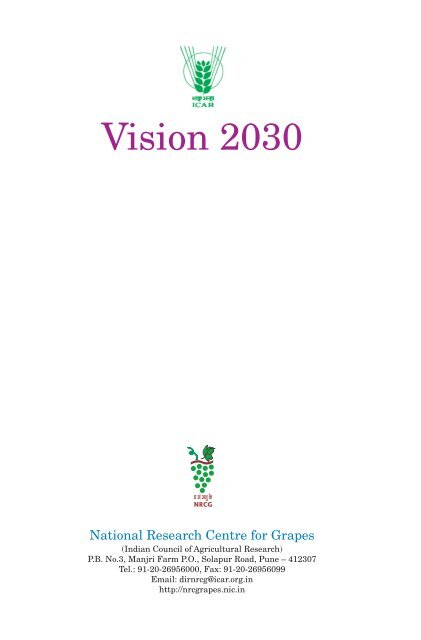


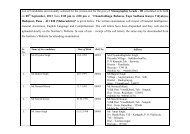
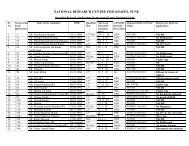

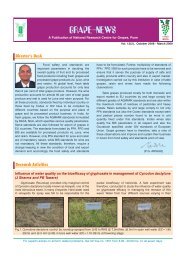

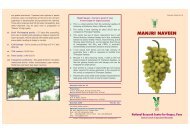
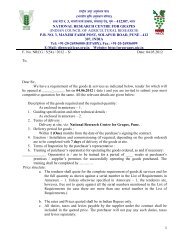



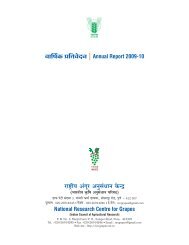
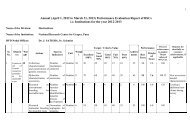
![mj]mJ{V cmcH$m{irM{ (_mBQâ¤>g) oZ`ÃÃU](https://img.yumpu.com/33367555/1/190x127/mjmjv-cmchmirm-mbqag-ozaau.jpg?quality=85)